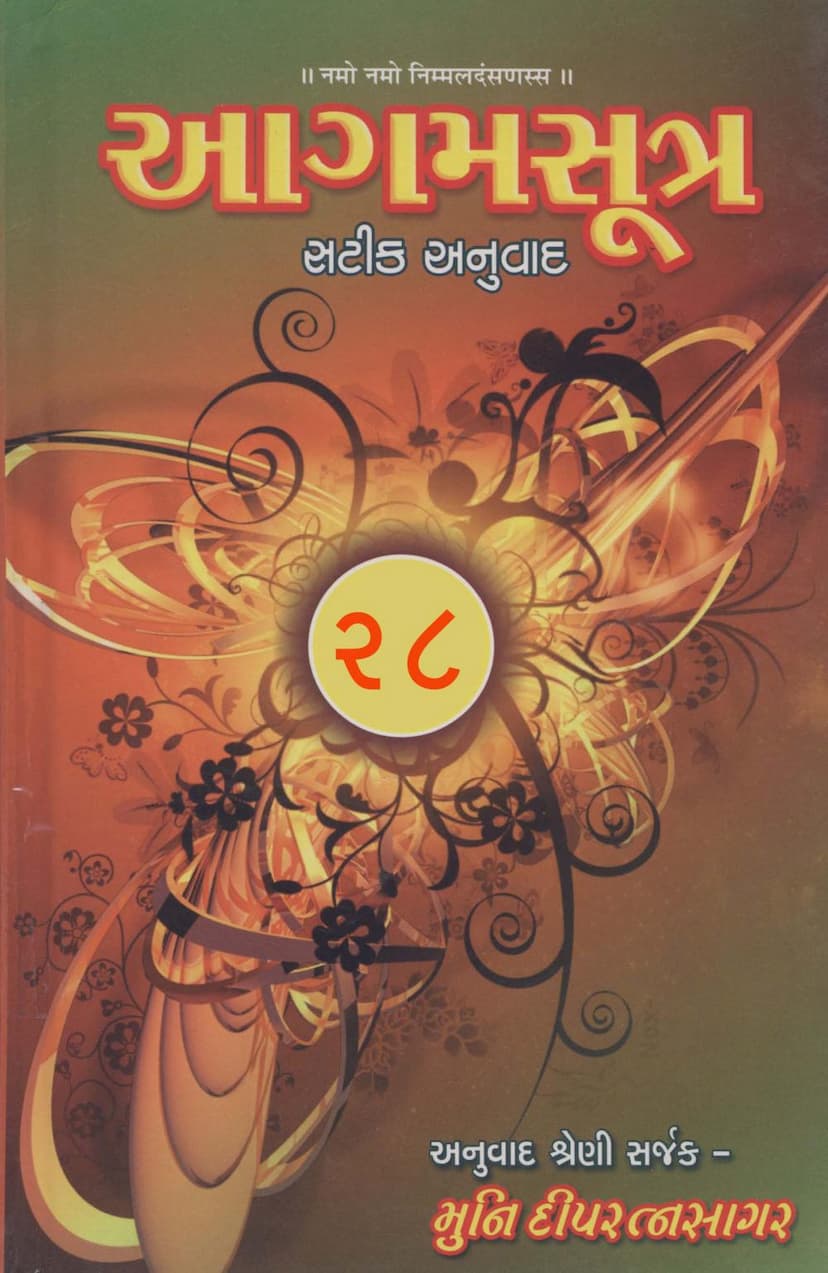Agam 21 Pushpika Sutra Satik Gujarati Anuvad
Added to library: September 1, 2025

Summary
Here's a comprehensive summary of the provided Jain text, focusing on "Agam 21 Pushpika Sutra Satik Gujarati Anuvad" (Agam 21 Pushpika Sutra with Commentary Gujarati Translation):
Overview of the Publication:
The text is a Gujarati translation with commentary of Agam 21, specifically the Pushpika Sutra, which is an Upanga Sutra within Jain Agamas. The publication is part of a larger series titled "Agam Satik Anuvad" (Agam with Commentary Translation) by Muni Dippratnasagar. This particular volume, referred to as "Bhag 28" (Part 28) of the translation series, focuses on the "Nirayavalika-Panchak" (Five Nirayavalikas) and "Payannao-101" (101 Payannas), with Pushpika being one of the five Upanga Sutras.
Core Content of Pushpika Sutra (as presented):
The Pushpika Sutra is described as the third section of the Nirayavalika. It comprises ten chapters (Adhyayanas). The provided text details the first five chapters of the Pushpika Sutra:
- Chapter 1: Chandra (Moon): This chapter narrates the story of Chandra, a celestial being in the Sudharmakalpa (a heaven). The narrative involves his previous life as Angati, a householder in Shravasti, who embraced Jainism and achieved his celestial birth. The chapter highlights the concept of rebirth and the celestial existence of beings based on their karma.
- Chapter 2: Surya (Sun): Similar to the first chapter, this discusses Surya, another celestial being. His previous life as Supati, a householder, and his journey towards achieving celestial status after embracing Jainism is described.
- Chapter 3: Shukra (Venus): This chapter focuses on Shukra, a celestial being. The narrative includes his past life as Somil, a Brahmin in Varanasi, who engaged in various ascetic practices and rituals. The story details his questioning of Jain principles and eventual acceptance, followed by his rebirth as Shukra. The text emphasizes the various austerities and rituals performed by Somil and his eventual spiritual progression.
- Chapter 4: Bahupurika (Many-Purified/Many-Children): This chapter tells the story of Bahupurika, a goddess in Saudharmakalpa. Her previous life as Subhadra, wife of a merchant named Bhadra, is recounted. Subhadra's sorrow over not having children and her subsequent seeking of spiritual guidance from a Jain nun are detailed. After embracing the Jain path, she eventually attains her celestial life as Bahupurika. The chapter also explains why she is called Bahupurika (due to her actions in her previous life) and her future rebirth.
- Chapter 5: Purnabhadra: This chapter narrates the story of Purnabhadra, a celestial being. His previous life as Purnabhadra, a householder in Manikita, and his spiritual journey after encountering Jain monks are described. His acceptance of Jain teachings and subsequent rebirth as Purnabhadra in a celestial realm are discussed.
Key Themes and Concepts:
- Karma and Rebirth: The central theme across the summarized chapters is the Jain principle of karma and its influence on rebirth. The stories illustrate how actions (karma) in past lives determine one's present and future existences, including celestial births and the specific characteristics of those births.
- Jain Practices and Principles: The text highlights the importance of accepting Jain teachings, embracing the path of renunciation (diksha), performing austerities (tapas), and following the path of righteousness. The narratives show individuals being motivated by spiritual teachers and eventually achieving higher states of existence.
- Celestial Beings and their Lives: The chapters describe the lives of various celestial beings (devas) who were formerly humans. Their lifespan, powers, and the reasons for their celestial existence are explained through their past karmic actions.
- The Role of Spiritual Teachers: The influence of Jain monks and nuns (munis and aryikas) is evident, as they guide individuals towards the right path and explain the profound principles of Jainism.
- Detailed Storytelling: The text provides detailed accounts of the past lives of celestial beings, including their names, professions, the cities they lived in, their families, and the specific events that led to their spiritual progress or downfall.
Publication Details and Acknowledgements:
The publication is a Gujarati translation with commentary, indicating a significant effort to make the Agamas accessible to Gujarati-speaking readers. The publisher is Deepratnasagar, and the author/translator is Muni Dippratnasagar. The text also includes extensive acknowledgments to various individuals and Jain Sanghs (organizations) who financially supported this ambitious project, highlighting a community effort in preserving and disseminating Jain scriptures. The publication is part of a larger series of 42 volumes and a total of 301 publications by Muni Dippratnasagar.
In essence, this excerpt provides a glimpse into the Pushpika Sutra by detailing the previous lives and spiritual journeys of several celestial beings, illustrating the Jain principles of karma, rebirth, and the efficacy of following the teachings of the Tirthankaras.